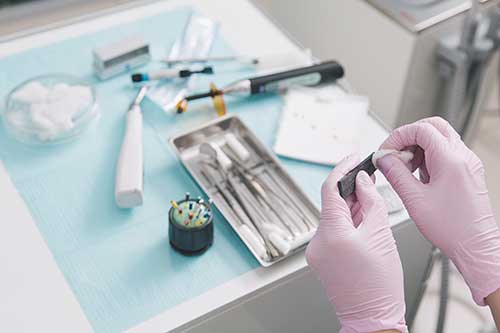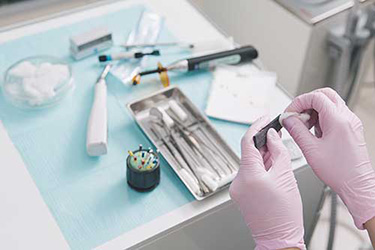Dental Exams and X-Ray
How Important is a dental Exam?
Dental exams give us the opportunity to evaluate your current methods of dental care and provide suggestions for future care in order to protect you from complications such as cavities and gum disease. They also allow us to detect problems early so they can be fixed quickly and easily.
How Often Should You Get a Dental Exam?
Dental exams should generally take place every six months. However, consult with our team to decide how often you should be examined, for we may suggest that you visit more frequently based on factors such as smoking, frequency of cavities and genetic susceptibility to tooth and root decay as well as gum disease.
What can I expect from a dental Exam?
At a typical dental exam, we will check for signs of decay or gum disease. An X-ray may be performed to provide a more detailed summary of your oral health and to more closely identify any problems. We will ask you questions about your current methods of dental care, such as how often you brush your teeth, and floss, as well as whether you use a toothpaste with fluoride. With this information in mind, we will demonstrate proper dental care and provide suggestions on how to improve your habits to promote optimal oral health.
Teeth Cleaning / Oral Hygiene
A dental prophylaxis is a cleaning treatment performed to thoroughly clean the teeth and gums. Oral hygiene is necessary for eliminating bacteria in the mouth. Bacteria builds to form plaque that can harden and lead to long-term ailments such as gingivitis, a mild form of gum disease, and periodontal disease if it is not removed. A good dental care routine and regular check ups will keep your mouth healthy and prevent inflammation, infection, decay, and tooth loss.
Dental prophylaxis is an effective procedure in keeping the oral cavity in proper health and halting the progression of gum disease.
The benefits of professional teeth cleaning include:
- Plaque removal. Tartar (also referred to as calculus) and plaque buildup, both above and below the gum line, can result in serious periodontal problems. Unfortunately, even with a proper home brushing and flossing routine, it can be impossible to remove all debris, bacteria and deposits from gum pockets. The experienced eye of a dentist or hygienist using specialized dental equipment is necessary to catch potentially damaging buildup.
- A healthier looking smile. Stained and yellowed teeth can dramatically decrease the esthetics of a smile. Prophylaxis is an effective treatment in ridding the teeth of these unsightly stains.
- Fresher breath. Bad breath (or halitosis) is generally indicative of advancing periodontal disease. A combination of rotting food particles (possibly below the gum line) and potential gangrene stemming from gum infection, results in bad breath. The routine removal of plaque, calculus and bacteria at our facility can noticeably improve halitosis and reduce infection.
Dental Sealants
Highly effective in preventing decay on the biting surfaces of your chewing teeth, sealants are a simple procedure in which a tooth-colored acrylic “coating” is painted onto the surface of the tooth. Dental sealants effectively “seals” the deep grooves, acting as a barrier and protecting enamel from plaque and acids.
Dental sealants protect the depressions and grooves of your teeth from food particles and plaque that brushing and flossing can’t reach.
Easy to apply, dental sealants take only a few minutes to seal each tooth. Sealants hold up well under the force of normal chewing and can last several years before a reapplication is needed.
Children and adults can benefit from dental sealants in the fight against tooth decay.


How long does it take to fit a dental crown?
Fitting a crown requires at least two visits to our office. Initially, we will remove decay, shape the tooth and fit it with a temporary crown. On the subsequent visit, we will remove the temporary crown and then fit and adjust the final crown. Finally, we will cement the crown into place and you have a new beautiful looking tooth.
Scaling & Root Planning / Deep Teeth Cleaning
The initial stage of treatment for periodontal disease is usually a thorough cleaning that may include scaling or root planning. The objective of these non-surgical procedures is to remove etiologic agents such as dental plaque and tartar, or calculus, which cause gingival inflammation and disease. Scaling and root planning can be used as a stand-alone treatment or a preventative measure. They are commonly performed on cases of gingivitis and moderate to severe periodontal disease.
What are the procedures of scaling and root planing?
When scaling is performed, calculus and plaque that attaches to the tooth surfaces is removed. The process especially targets the area below the gum line, along the root. Scaling is performed with a special dental tool called an ultrasonic scaling tool. The scaling tool usually includes an irrigation process that can be used to deliver an antimicrobial agent below the gums to help reduce oral bacteria.
Root planning is performed in order to remove cementum and surface dentin that is embedded with unwanted microorganisms, toxins and tartar. The root of the tooth is literally smoothed, which promotes healing, and also helps prevent bacteria from easily colonizing in the future.
When deep pockets between teeth and gums are present, it is difficult to thoroughly remove plaque and tartar. Patients can seldom if ever, keep these pockets clean and free of plaque. Consequently, surgery may be needed to restore periodontal health.
Benefits of Treatment
Research has proven that bacteria from periodontal infections can travel through the blood stream and affect other areas of the body, sometimes causing heart and respiratory diseases. Scaling and root planning remove bacteria that cause these conditions.
Another benefit of treatment is protecting teeth against tooth loss. When gum pockets exceed 3mm in depth, the risk for periodontal disease increases. As pockets deepen, more bacteria are able to colonize, eventually causing a chronic inflammatory response by the body to destroy gingival and bone tissue. This leads to tooth loss.
Finally, scaling and root planning may make the mouth more aesthetically pleasing and should reduce bad breath caused by food particles and bacteria in the oral cavity. Superficial stains on the teeth will be removed during scaling and planning, adding an extra bonus to the procedures.
